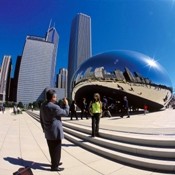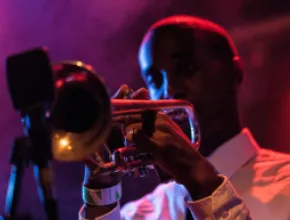Chicago has been celebrated so often in song—Take Me Back to Chicago, Sweet Home, Chicago and at least 10 songs just called Chicago—that you have to take a minute when you arrive to separate the city from the songs.
Start out downtown. Whether you arrive by train or car, you start taking in the buildings, the people, the aroma of restaurant food, the energy—the buzz that says “big city”—and whatever you do from that point on has a little extra glow that songs just can’t give you.
Downtown Chicago is miles long and miles wide, but its compact street grid and prominent landmarks—Sears Tower, the twin-spired John Hancock building, Lake Michigan, Grant and Millennium parks, the Chicago River—make it easy to navigate on foot or by car. The city has been famed for its architecture since early in the 20th century, and it seems like nearly every structure, including the parking garages, makes an architectural statement: Breathtakingly modern! Neo-Gothic! Sleekly Art Deco! Classically Beaux-Arts!
Simply walking around downtown can be a distraction to anyone interested in building styles, and it’s sometimes a relief to go indoors for awhile.
Big Business
Like other great cities, Chicago’s size and prosperity mean it has the resources to help you accomplish whatever your group requires, says Mark Theis, executive vice president, sales, for the Chicago Convention and Tourism Bureau (CCTB).
“Chicago is a city that means big business and does big business, and it’s a city that is making sure they continue to set themselves up to be the best, with an investment in new hotels, airport improvements, new attractions like Millennium Park—a huge outdoor open space next to the lake with the Frank Gehry-designed Pritzker Pavilion—and a promising bid for the 2016 Olympics.”
There’s no shortage of places to stay; the central business district alone has 30,000 hotel rooms out of about 100,000 in the overall Chicago metropolitan area. Dozens of hotels of every style are well equipped with meeting facilities, and the majority of properties are situated in the vibrant downtown core, up and down Michigan Avenue and along the streets that parallel and intersect it.
North of the Chicago River, options include the Westin River North, the Westin Michigan Avenue Chicago, the Millennium Knickerbocker, The James Chicago, the Chicago Marriott Downtown, the Omni Ambassador East, the Sheraton Chicago Hotel and Towers, the Four Seasons Hotel Chicago, the InterContinental Chicago, and The Allerton Hotel.
Just south of the Chicago River are the Hyatt Regency Chicago (with its own excellent steakhouse, Stetson’s), the Fairmont Chicago, the Renaissance Chicago, the Palmer House Hilton, Hotel Allegro, and Hotel 71. The boutique Hotel Monaco deserves a mention for its central location and extraordinary pet-friendliness—an important consideration for attendees seeking to take their pets along.
Farther south, toward McCormick Place, groups can opt for the Congress Plaza, the Hilton Chicago and the Hyatt Regency McCormick Place. In the Midway International Airport area, a cluster of hotels are suited to meetings, including the Marriott Chicago Midway Airport.
Venues with a View
McCormick Place, located just a few miles south of the downtown core and offering beautiful views of Lake Michigan, its own commuter rail station and a dedicated busway, is the largest convention venue in the U.S. It has 2.2 million square feet of exhibit space (1.6 million on one level), plus an additional 700,000 square feet slated to come online in July at the new McCormick Place West. Just next door is Chicago’s largest theater space, the 4,249-seat Arie Crown Theater.
Just east of downtown, jutting out onto Lake Michigan, is historic Navy Pier, another standout gathering spot with a variety of distinctive venues. Its main Festival Hall has 170,000 square feet of exhibition space, while the Lakeview Terrace seats 1,000 for dinner and can serve as prefunction space for the 1916 Grand Ballroom, whose 80-foot dome and views of Lake Michigan make the most of the pier’s premier location. The pier also has more-modest facilities, such as the 510-seat, wraparound Shakespeare Theatre, where no seat is more than nine rows from the stage.
Chicago also has many unique smaller venues, according to Bart Louhi, CEO of In the Loop–Chicago, which describes itself as a “special event and destination management company with a fresh twist.”
“The Hudson Club in the South Loop is an old car dealership that is now a funky, big, dynamic space,” Louhi says. “The Chicago Illuminating Company in the South Loop is an old lighting company building that was renovated into a great event space no more than 10 minutes from the convention center. And the Chicago History Museum just completed a renovation, and there are a couple of event spaces where they did an incredible job.”
Good Eats
When it comes to food, most attendees will be familiar with Chicago’s reputation as a beef town, and the city doesn’t disappoint. From Italian beef sandwiches at extremely casual places like Portillo’s—get extra napkins with whatever you order—to some of the best steak houses in the country, Chicago caters to your beef fantasies. In the River North area, Wildfire has a 1940s supper club ambience with a modern touch and offers private rooms that accommodate up to 125 for lunch (when the restaurant is closed to the public and your group would have the place to itself). For more of a Latin flair, walk over to Frontera Grill or neighboring Topolobampo for celebrity chef Rick Bayless’ innovative takes on Latin American cuisine.
And perhaps you’ve heard about Chicago-style deep-dish pizza? Look no further than Gino’s East or Giordano’s.
Incidentally, if your server at any restaurant here says to order the small size of a particular dish, do it—portions (and drinks) can be intimidatingly large.
On the Town
For nightlife, Chicago has dozens of venues for theater, comedy and live music. Those most familiar to visitors might include Second City, the improv-comedy troupe in the Old Town neighborhood that spawned Saturday Night Live sensations like John Belushi, Dan Aykroyd and Bill Murray, and Steppenwolf Theatre, the famed company co-founded by Gary Sinise that has helped launch the careers of Joan Allen, Laurie Metcalf and John Malkovich.
Chicago’s list of cultural attractions seems endless, but a quick mention of a few, along with their most current events, should steer attendees in the right direction: At the Oriental Theatre, Wicked is finishing up its second year and tickets are still tough to find. The Field Museum’s Dinosaurs: Ancient Fossils, New Discoveries show will run through Sept. 3; the Art Institute shows no signs of taking down either Grant Wood’s American Gothic or Edward Hopper’s The Nighthawks; the flowers are in bloom at Lurie Garden along with the permanently beautiful, Frank Gehry-designed band shell at Millennium Park; and football’s Bears and baseball’s Cubs will continue to play (in season) at Soldier and Wrigley fields, as the CCTB’s Theis emphasizes.
“Arts and culture is a huge component of Chicago, and then there’s also the whole sports component year-round, with two baseball teams, football and basketball,” he says. “No one denies that Chicago is all about sports.”
Chicago is also a great shopping town, with practically every famous department and specialty store represented, from Barney’s New York and Bloomingdale’s along Michigan Avenue to Macy’s and Carson Pirie Scott along State Street.
Attendees may also enjoy stopping by the headquarters of the Tribune Company along Michigan Avenue, which has built into its neo-Gothic facade pieces of historic structures from around the world, including the Taj Mahal, Notre Dame and the Great Wall of China. While there, visitors can walk a few blocks east on Illinois Street to have breakfast at Fox & Obel, a gourmet market that has an excellent small cafe suitable for about 40 inside.
South of downtown, Chicago offers a substantial Chinatown as well as the sizable University of Chicago campus and surrounding bookstores.
There are also several other notable ethnic neighborhoods in Chicago, including Greektown, Ukrainian Village and even Little Saigon, which is just north of Wrigley Field. Bohemian Wicker Park and Bucktown are gentrifying rapidly, but not fast enough to chase away funky bookstores, boutiques and cafes.
Access to the city is straightforward thanks to the surrounding network of interstates, even if traffic can sometimes be heavy. Chicago is also a major passenger rail hub served by Amtrak (trains called California Zephyr and City of New Orleans hint at the distance you can go from here by rail), while Midway and O’Hare international airports have service to just about every gateway in the U.S. and dozens of foreign cities. Both are served by Chicago’s extensive commuter rail system, which can bring visitors directly to downtown without the need for a rental car.
For More Info
Chicago Convention and Tourism Bureau 312.567.8500
www.choosechicago.com






